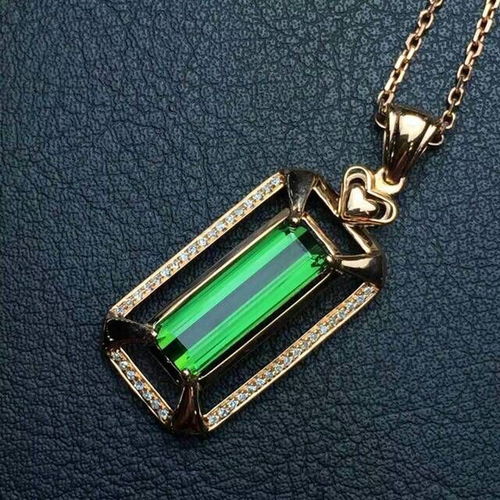1.【悬赏50分】求碧玺的英文简介
Today, gem and specimen tourmaline is mined chiefly in Brazil and Africa. Some placer material suitable for gem use comes from Sri Lanka. Some fine gem and specimen material has been produced in the US, with the first discoveries having been made in 1822, in the state of Maine. California became a large producer of tourmaline in the early 1900s. The Maine deposits tend to produce crystals in raspberry pink-red as well as minty greens. The California deposits are known for bright pinks, as well as interesting bicolors. During the early 1900s, Maine and California were the worlds largest producers of gem tourmalines. The Empress Dowager Tz’u Hsi, the last Empress of China, loved pink tourmaline and bought large quantities for gemstones and carvings from the then new Himalaya Mine, located in San Diego County, California. [4] Almost every color of tourmaline can be found in Brazil, especially in the Brazilian states of Minas Gerais and Bahia. In 1989, miners discovered a unique and brightly colored variety of tourmaline in the state of Paraíba. The new type of tourmaline, which soon became known as paraiba tourmaline, came in unusually vivid blues and greens. These colors were often described as “neon” since they appeared to glow. Brazilian paraiba tourmaline is usually heavily included. Much of the paraiba tourmaline from Brazil actually comes from the neighboring state of Rio Grande do Norte. Material from Rio Grande do Norte is often somewhat less intense in color, but many fine gems are found there. It was determined that the element copper was important in the coloration of the stone. The demand and excitement for this new material, which has fetched more than $50,000 per carat, earned more respect for the other colors of tourmaline. In the late 90s, copper-containing tourmaline was found in Nigeria. The material was generally paler and less saturated than the Brazilian materials, although the material generally was much less included. A more recent African discovery from Mozambique has also produced beautiful tourmaline colored by copper, similar to the Brazilian paraiba. While its colors are somewhat less bright than top Brazilian material, Mozambique paraiba is often less included and has been found in larger sizes. The Mozambique paraiba material usually is more intensely colored than the Nigerian. There is a significant overlap in color and clarity with Mozambique paraiba and Brazilian paraiba, especially with the material from Rio Grande do Norte. While less expensive than top quality Brazilian paraiba, some Mozambique material sells for well over $5,000 per carat, which still is extremely high compared to other tourmalines. Tourmaline mineral (~ 10 cm tall)Another unique variety that is also highly valued is chrome tourmaline, a rare type of dravite tourmaline from Tanzania which occurs in a very rich green color caused by chromium, the same element which causes the green in emerald. Of the standard Elbaite colors, generally blue indicolite gems are the most expensive, followed by green verdelite and pink to red rubellite. There are also yellow tourmalines, sometimes known as canary tourmaline. Ironically the rarest variety, colorless achroite, is not appreciated and is the least expensive of the transparent tourmalines. In addition to Brazil, significant amounts of tourmaline are also mined in Tanzania, Nigeria, Kenya, Madagascar, Mozambique, Namibia, Afghanistan, Pakistan, and Sri Lanka, and Malawi.[5] Some tourmaline gems, especially pink to red colored stones, are altered by irradiation to improve their color. Irradiation is almost impossible to detect in tourmalines, and does not impact the value. Heavily-included tourmalines, such as rubellite and Brazilian paraiba are sometimes clarity enhanced, which must be disclosed to the buyer. A clarity-enhanced tourmaline (especially paraiba) is worth much less than a non-treated gem。
2.碧玺的英文怎么说
一、碧玺的英文tourmaline。
例句
1. 碧玺是世界上最多彩的自然宝石。
Tourmaline is the most multi-colored natural gemstone in the world. 2. 蓝色碧玺是碧玺的一种蓝色变种,也是整个碧玺家族中价格最高的颜色之一。
Indicolite is the blue variety of Tourmaline and is one of the most prized colors of the entire Tourmaline Family. 二、电气石,俗称碧玺、碧茜,又译为托玛琳。具石英等所拥有的压电效应。产地包括巴西、斯里兰卡、马达加斯加等。目前在国际珠宝市场上,帕拉依巴‧碧玺等有色电气石深受收藏家注目。硬度介于7-7.5之间,折射率约为1.62-1.64之间,折射率差约在0.020。由于帕拉依巴内部含有铜元素,因此会呈现出自然而鲜艳的蓝绿色,即便是在自然光或无光源的环境中,也会散发出霓光色泽,这可说是帕拉依巴‧碧玺最吸引人的特色之一。
3.碧玺的知识
一、碧玺的简介
(1)碧玺是化学成分复杂的多种金属硼硅酸盐,矿物名称叫电气石。碧玺的颜色丰富多彩,既有红色、绿色、蓝色、粉红色、黑色和无色等,也有几种颜色长在一个晶体上的情况。其中有一种外层为绿色,内层为粉红色,称为西瓜碧玺,十分奇特,价值很高。
(2)碧玺呈玻璃光泽,透明—不透明。在宝石显微镜下观察的特征是:常有裂隙和气液包体,还可见平行排列针状包体,当针状包体很密集时,便显示猫眼效应。红色碧玺有时易与红宝石相混淆。在市场上,透明的碧玺常琢磨成刻面,半透明的琢成弧面,而微透明的常雕刻成各种题材的小挂件,是受欢迎的中档宝石。
(3)碧玺主产国是美国。我国新疆出产的西瓜碧玺非常有名。云南省也有优质碧玺产出。
二、碧玺的保养:
1、避免碧玺受到碰撞:佩带碧玺饰品就尽量避免干粗重活或剧烈的运动,以免对碧玺造成碰撞而带来难以弥补的损坏。碧玺摩氏硬度在7到7.5之间,但还是很脆,如受到磕碰则很容易使碧玺出现裂痕.
2、避免对镶嵌款式碧玺饰品的撞击:没有边镶和微镶的碧玺饰品是为能了更好的凸显出碧玺的美观,但是缺陷就是固性不高,很易脱落,所以要尽量避免碰撞,如发现饰品有松动的情况,应实时拿到专业的维修店进行修缮,以免碧玺宝石出现更大的损伤。
3、定期清洗:如果是长时间佩带碧玺,则在碧玺饰品上会附着人体排泄的油脂和汗渍,所以为了保持碧玺饰品的关泽,需要每月用清水浸泡碧玺饰品数小时后用柔软的棉布擦干便可。
4、存放适宜:不能将碧玺饰品与其它的饰品同放置于在一个首饰盒内,很可能会因为相互的摩擦而招致饰品有所磨损。为了保持饰品的持久性和完整性,不光是碧玺饰品,其他任何珠宝饰品也最好是单独存放。
5、定期检查:碧玺饰品一旦佩戴一定时间后,应该每月进行一次检查,以免出现镶嵌松脱的现象。
4.碧玺的英文怎么说
一、碧玺的英文tourmaline。
例句碧玺是世界上最多彩的自然宝石。Tourmaline is the most multi-colored natural gemstone in the world.蓝色碧玺是碧玺的一种蓝色变种,也是整个碧玺家族中价格最高的颜色之一。
Indicolite is the blue variety of Tourmaline and is one of the most prized colors of the entire Tourmaline Family.二、电气石,俗称碧玺、碧茜,又译为托玛琳。具石英等所拥有的压电效应。
产地包括巴西、斯里兰卡、马达加斯加等。目前在国际珠宝市场上,帕拉依巴‧碧玺等有色电气石深受收藏家注目。
硬度介于7-7.5之间,折射率约为1.62-1.64之间,折射率差约在0.020。由于帕拉依巴内部含有铜元素,因此会呈现出自然而鲜艳的蓝绿色,即便是在自然光或无光源的环境中,也会散发出霓光色泽,这可说是帕拉依巴‧碧玺最吸引人的特色之一。
5.急求全部关于珠宝的英文知识
红宝石(Ruby)
蓝宝石(Blue Sapphire)
祖母绿(Emerald)
彩色蓝宝石(Fancy Colored Sapphire)
碧玺(Tourmaline)
尖晶石(Spinel)
金绿宝石猫眼(Cat’s eye)
变石(Alexandrite)
海蓝宝(Aquamarine)
珊瑚(Coral)
黄晶(Citrine)
紫水晶(Amethyst)
石榴石(Garnet)
橄榄石(Peridot)
斑彩石(ammolite)
彩色钻石(Colored Diamond) 红碧玺(Rubellite)
绿碧玺(Verdelite)
蓝碧玺(Indicolite)
双色碧玺(Bi-Colored Tourmaline)
帕拉依巴碧玺(Paraiba)
坦桑石(Tanzanite)
托帕石(Topaz)
摩根石(Morganite)
锆石(Zircon)
堇青石(Dichroite)
绿柱石(Beryl)
金绿宝石(Chrysoberyl)
绿松石(Turquoise)
欧泊(Opal)
6.碧玺的矿物知识,要专业点的,矿物岩石学,谢谢了
“十月诞生石”——碧玺碧玺的矿物学上命名为电气石,是因为碧玺的热电性与压电性。
碧玺的化学成分非常复杂,是含硼的硅酸盐类矿物,并且这些矿物元素有多种不同的组合方式,不同的组合形成不同的化学式,如钙镁电气石、镁铁锂电气石、布格电气石、钠锰电气石等。对于碧玺的化学式,一直存在争议,但如今被大多数人认可的化学式是(Na,Ca)RAl6[Si6O18][BO3]3(C,OH,F)4,其中R可以由其他元素代换,如:Fe、Li、Mg、Mn,Al、Fe+3、Cr+3等等。
复杂的化学组成让碧玺不易人工合成以及仿制,但如今国外还是出现了人工合成的绿碧玺,但因成本过大的问题,并未进行市场推广。此外,Fe、Li、Mg、Mn,Al、Fe+3、Cr+3等元素是碧玺的致色元素,让碧玺的颜色丰富而多变,有红色、绿色、蓝色、黑色、黄色、红绿双色等等,其中红色、蓝色以及红绿双色等碧玺较为名贵。
碧玺硬度介于7-7.5之间。折射率值为1.624-1.644。
双折射率值为0.018,因此成品中看底部的刻面棱,具有十分明显的重影特征,这是肉眼鉴定碧玺的重要依据。碧玺具有明显的多色性,很多时候肉眼可见碧玺体色深浅的变化,这也是重要的鉴定依据之一。
比重为3.01-3.11g/cm3。碧玺晶体内多含气液二相包体,针管状包体含量较多,因而净度高的碧玺非常少,一般5克拉以上纯净、切工好的碧玺就达到了收藏级别。
二次世界大战之初,碧玺是唯一可以判定核爆压力的物质。在科学上用于发光强度与压力变化的测定,被广泛运用于光学产业。
后因色泽、美感等多作宝石装饰佩戴。在中国,碧玺这个名词最早出现于清代典籍《石雅》之中:“碧亚么之名,中国载籍,未详所自出。”
《清会典图云》:“妃嫔顶用碧亚么。《滇海虞衡志》:碧霞碧一曰碧霞玭,一曰碧洗;玉纪又做碧霞希。
今世人但称碧亚,或作碧玺,然已无问其名之所由来者,惟为异域方言,则无疑耳。”碧玺读音时与“避邪”相近似,所以人们认为佩戴碧玺具有护身符的作用,且民间还有旺夫、旺运的说法。
其实碧玺是不能跟白水晶、紫水晶、黄水晶等晶莹通透类的水晶相比较的,冰裂纹是它遗憾的特质,而色彩的艳丽则是众人追求喜爱的根源;所以选择碧玺就要接受一点遗憾了。碧玺是仅次于红宝石、祖母绿、变石的中高档宝石。
其以颜色鲜艳、美丽、多变,透明度高,自古以来深受人们喜爱。人们把碧玺定为”十月诞生石”,象征安乐与和平。
据记载,清朝慈禧太后对碧玺也是倍加有爱,在她的殉葬品中,脚下就踩有一朵用碧玺雕琢而成的莲花,重量为36.8钱,当时的价值也为75万两白银。近年来随着流行饰品的兴起,碧玺也以晶莹剔透的品质和丰富多彩的颜色,成为时尚首饰的新宠,其价位也一涨再涨,一条质量高的碧玺手链价值可以高达数千元甚至数万元,让人刮目相看。
一、碧玺的特征 碧玺的名称 碧玺的矿物学名称为电气石,英文名称为Tourmaline,是从古僧伽罗语“Turmali”一词衍生而来的,意为“混合宝石”。在我国的一些历史文献中称为“砒硒”、“碧玺”、“碧霞希”、“碎邪金”等。
碧玺的晶体 碧玺为复三方柱状晶体,晶体表面会出现特征的平行沿柱状晶体的延长方向的生长条纹。而在横断面上看则为带弧面的球面三角形。
碧玺的颜色 碧玺的颜色是各类宝石中最为丰富的了。由于碧玺属于复杂的硼硅酸盐矿物,化学分子式为Na(Mg,Fe,Mn,Li,Al)3Al6[Si6O18][BO3]3(OH,F)4,其中铁、镁、锂、锰、铝等金属离子可以相互替代,各离子的含量的不同,会直接影响到碧玺颜色和种类的不同。
富铁碧玺呈黑色和绿色;富镁碧玺显示黄色或褐色;富锂、锰、铯碧玺显示玫瑰红色、粉红色、红色或蓝色;富铬碧玺显示深绿色。其中以蔚蓝色和鲜玫瑰红色碧玺为上品。
在同一碧玺晶体中,由于成分的分布不均匀性,也往往会导致颜色的变化,沿碧玺出现双色碧玺、多色碧玺或内红外绿的西瓜碧玺等类型。 碧玺的多色性 碧玺除了具有丰富多彩的颜色外,最为吸引人的还在于它的多色性。
当我们手持碧玺对照光线转动以不同的角度进行观察时,碧玺的颜色色调和深浅程度会随着观察的角度不同而发生改变。这是由于碧玺拥有较强的多色性所至,这也为碧玺披上了神秘的色彩。
碧玺的压电效应和热电效应 当碧玺经过加热或施加压力后,或者利用丝绸或毛料加以摩擦,会使柱状碧玺两端产生电极效应,一端为正电,另一端为负电,这会使碧玺会将一些灰尘或小纸屑吸引起来,该神奇的力量便是碧玺的压电效应和热电效应,也是“电气石”这一名称的由来。曾经有一段有趣故事:传说1703年,一个温暖的夏天,在荷兰的阿姆斯特丹,有几个小孩在玩荷兰航海者带回的石头。
突然,一个小孩发现这些石头将近处的灰尘和草屑纷纷吸了过去。小孩十分惊奇,便叫他们的父母来看,果然发现这种石头能吸引或排斥轻物体,如灰尘和草屑等。
从此,荷兰人把它叫做”吸灰石”,并被用来清理烟管中的烟灰。 碧玺的猫眼效应 碧玺晶体内部会含有丰富的汽液包裹体,且往往呈定向分布,形成管状包裹体,密集的管状包裹体会使得加工成弧面形或圆珠状的碧玺出现猫眼效应—在碧玺表面出现一条明显光亮带,而且随着观。

